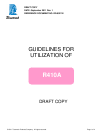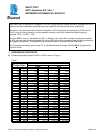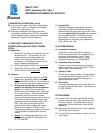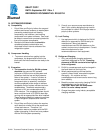
© 2011 Tecumseh Products Company. All rights reserved. Page 4 of 4
DRAFT COPY
DATE: September 2011 Rev. 1
REFERENCE DOCUMENT NO. RD-0027-E
IV. SYSTEM PROCESSING
A) Compatibility
1. Polyol Ester and Polyvinyl ether oils are good
solvents and have a tendency to wash system
processing materials such as drawing
components, rust inhibitors, and cleaning
compounds from system surfaces. Care must
be taken to remove such processing materials
from all the system components.
2. Residual chlorinated materials should be
considered system contamination and
eliminated from all internal surfaces of the
refrigeration system.
B) Compressor Handling
1. To prevent moisture from getting into the
compressor, the plugs should be left in the
tubes until the line connections are ready to be
brazed.
C) Evacuation
1. The evacuation levels for R410A systems
should be the same as R22 systems
(minimum of 200 microns at the system and
pulled from both the low and high pressure
sides of the system). If care is not taken to
prevent moisture from entering the system
components prior to assembly, evacuation
could be expected to take longer to achieve
acceptable limits of system moisture and non-
condensables. Tecumseh recommends a
maximum of 2% non-condensable and 80
PPM moisture. The completed system should
have a moisture level of 50 PPM or less after
running with an appropriate filter-drier installed.
These levels are based on measuring moisture
in liquid refrigerant samples taken from the
system.
2. Polyol Ester and Polyvinyl ether oils vaporize
much less than mineral oils at the same level
of heat and vacuum. Therefore, if oil
vaporization was not a problem with the R22
system processing, it should not be a problem
with the R410A system processing.
3. Consult your vacuum pump manufacturer to
learn if your existing equipment may need to
be converted for use on R410A polyol ester or
polyvinyl ether systems.
D) Leak Testing
1. Use equipment which is designed for R410A
detection or approved for R410A use by its
manufacturer. Many leak detector
manufacturers have R410A detectors on the
market, and more are in development. Consult
these manufacturers for their
recommendations on their equipment.
E) Refrigerant Charging
1. Only use refrigerant charging equipment
specifically designed for R410A. Operating
pressures of R410A can be twice as high as
other refrigerants.
2. R410A is a azeotrope and must be charged in
the liquid state into the liquid line.
3. When pressure testing confirms that the
system is free of leaks, evacuate the system
thoroughly. Air, moisture and non-
condensables must be removed to ensure long
term reliability.
4. Break the system vacuum by charging R410A
liquid refrigerant into the liquid line.
CAUTION: Never start the compressor
while it is under a deep vacuum.
5. Charge the system using industry acceptable
charging methods.






